MCQ Refraction of Light Plane / Prism ICSE Physics Class-10 . These MCQ / Objective Type Questions is based on latest reduced syllabus according 2021-22 session on bifurcated pattern. Main motto of MCQ Type Question is cracking the next upcoming exam of council. Visit official website CISCE for detail information about ICSE Board Class-10 Physics.
ICSE Physics Class-10 MCQ Refraction of Light Through Plane / Prism MCQ Type Questions
| Board | ICSE |
| Class | 10th (X) |
| Subject | Physics |
| Chapter | Refraction of light plane / Prism |
| Syllabus | on bifurcated syllabus (after reduction) |
| Session | 2021-22 |
| Topic | MCQ / Objective Type Question |
MCQ Type Questions for ICSE Physics MCQ Refraction of Light through Plane / Prism Class-10
Question 1: When a ray of light from air enters a denser medium, it:
(a) Bends away from the normal
(b) Bends towards the normal
(c) Goes undeviated
(d) Is reflected back
Answer (b) Bends towards the normal
As the speed of light decreases in the denser medium, it bends towards the normal.
Question 2 :A light ray does not bend at the boundary in passing from one medium to the other medium if the angle of incidence is:
(a) 0°
(b) 45°
(c) 60°
(d) 90°
Answer (a) 0°
Reason: A ray of light which is incident normally (i.e. at angle of incidence = 0°) on the surface separating the two media, passes undeviated.
Question 3 The highest refractive index is of:
(a) Glass
(b) Water
(c) Diamond
(d) Ruby
Answer (c) Diamond
Reason: As the speed of light in diamond is the least, diamond has the highest refractive index.
Question 4 The speed of light in air is 3 x 108 m s-1. Calculate the speed of light in glass. The refractive index of glass is 1.5.
(a) v = 2 x 1012 m/s
(b) v = 24 x 1024 m/s
(c) v = 2 x 108 m/s
(d) v = 4 x 1016 m/s
Answer (c) v = 2 x 108 m/s
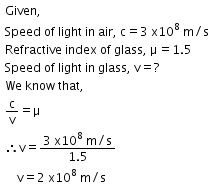
Question 5 In refraction of light through a prism, the light ray:
(a) Suffers refraction only at one face of the prism
(b) Emerges out from the prism in a direction parallel to the incident ray
(c) Bends at both the surfaces of prism towards its base
(d) Bends at both the surfaces of prism opposite to its base.
Answer (c) Bends at both the surfaces of prism towards its base
Question 6 A ray of light suffers refraction through an equilateral prism. The deviation produced by the prism does not depend on the:
(a) Angle of incidence
(b) Colour of light
(c) Material of prism
(d) Size of prism
Answer (d) Size of prism
Question 7 A ray of light incident at an angle 48o on a prism of refracting angle 60o suffers minimum deviation. Calculate the angle of minimum deviation.
(a) 𝛿min = 120
(b) 𝛿min = 240
(c) 𝛿min = 480
(d) 𝛿min = 360
Answer (d) 𝛿min = 360
Angle of incidence, i = 480
Refracting angle, A = 600
Angle of minimum deviation, 𝛿min =?
We know that
𝛿min = 2i – A
𝛿min = 2(48) – 60
𝛿min = 96 – 60
𝛿min = 360
Question 7 What should be the angle of incidence for a ray of light which suffers a minimum deviation of 36o through an equilateral prism?
(a) i = 12 0
(b) i = 240
(c) i = 480
(d) i = 600
Answer (c) i = 480
Angle of prism, A = 600
Angle of minimum deviation, 𝛿min = 360
Angle of incidence, i = ?
We know that
𝛿min = 2i – A
360 = 2i – 600
i = 480
Question 8 A small air bubble in a glass block when seen from above appears to be raised because of:
(a) Refraction of light
(b) Reflection of light
(c) Reflection and refraction of light
(d) None of the above
Answer (a) Refraction of light
Hint: When a ray of light travels from denser to rarer medium, it moves away from the normal.
Question 9 An object in a denser medium when viewed from a rarer medium appears to be raised. The shift is maximum for:
(a) Red light
(b) Violet light
(c) Yellow light
(d) Green light
Answer (b) Violet light
Hint: The shift is maximum for violet light because the refractive index of glass is the most for the violet light and apparent = (real depth)/(refractive index)
Question 10 A water pond appears to be 2.7 m deep. If the refractive index of water is 4/3, find the actual depth of the pond.
(a) 3.6 m
(b) 3.6 m
(c) 3.6 m
(d) 3.6 m
Answer (a) 3.6 m
Apparent depth = 2.7 m
Refractive index of water μw = 4 / 3
Real depth = Apparent depth × μw
Real depth = 2.7 × 4 / 3
Real depth = 3.6 m
Question 11 A coin is placed at the bottom of a beaker containing water (refractive index = 4/3) to a depth of 12 cm. By what height the coin appears to be raised when seen from vertically above?
(a) 2 cm
(b) 9 cm
(c) 3 cm
(d) 1.5 cm
Answer (c) 3 cm
Refractive index of the water, μw = 4 / 3
Real depth at which coin is placed = 12 cm
Shift in the image = ?
Shift = Real depth × (1 – 1 / μ)
Shift = 12 × (1 – 3 / 4)
Shift = 12 / 4
Shift = 3 cm or R = 3 cm
Question 12 A postage stamp kept below a rectangular glass block or refractive index 1.5 when viewed from vertically above it, appears to be raised by 7.0 mm. Calculate the thickness of the glass block.
(a) 3.1 cm
(b) 2.1 cm
(c) 2.5 cm
(d) 4.2 cm
Answer (b) 2.1 cm
Refractive index of the glass block, μg = 1.5
Shift in the image = 7 mm or 0.7 cm
Thickness of glass block or real depth = ?
Shift = Real depth × (1 – 1 / μ)
0.7 = R × (1 – 1 / 1.5)
R = (0.7 × 1.5) / 0.5
R = 2.1 cm
Question 13 The critical angle for glass-air interface is :
(a) 24°
(b) 48°
(c) 42°
(d) 45°
Answer (c) 42°
Question 14 A total reflecting right angled isosceles prism can be used to deviate a ray of light through
(a) 30°
(b) 60°
(c) 75°
(d) 90°
Answer (d) 90°
Question 15 A total reflecting equilateral prism can be used to deviate a ray of light through:
(a) 30°
(b) 60°
(c) 75°
(d) 90°
Answer (b) 60°
Question 16 The refractive index of water with respect to air is 4/3. What is the refractive index of air with respect to water?
(a) 0.5
(b) 0.75
(c) 1.5
(d) 0.70
Answer(b) 0.75
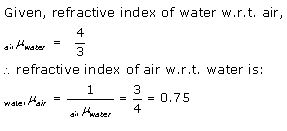
Question 17 A ray of light of wavelength 5400 Â suffers refraction from air to glass. Taking = μ=3/2, find the wavelength of light in glass.
(a) 1200 Â
(b) 4200 Â
(c) 4800 Â
(d) 3600 Â
Answer (d) 3600 Â
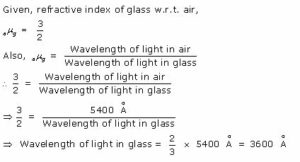
Question 18 When a beam of light strikes a glass slab a part of it is :
(a) reflected
(b) absorbed
(c) transmitted
(d) all of these
Answer: (a) reflected
Question 19 The phenomenon due to which a ray of light deviates from its path while travelling from one optical medium to another optical medium is called :
(a) dispersion
(b) refraction
(c) reflection
(d) diffraction
Answer: (b) refraction
Question 20 When a ray of light travelling in an optically denser medium, emerges into an optically less denser medium it :
(a) deviates towards the normal
(b) deviates away from normal
(c) does not deviate
(d) gets reflected
Answer: (b) deviates away from normal
Question 21 A ray of light strikes a glass slab at 90°. The angle of incidence is :
(a) 90°
(b) zero
(c) less than 90°, but not zero
(d) none of these
Answer: (b) zero
Question 22 Two medium ‘a’ and ‘b’ have same refractive index. A ray of light travelling from medium ‘a ’ to medium ‘b’. will suffer?
(a) refraction at the interfaces
(b) partly suffer reflection at the interfaces
(c) partly gets absorbed in medium ‘b ’
(d) both (b) and (c)
Answer: (b) partly suffer reflection at the interfaces
Question 23 A ray of light on entering from medium ‘a’ to medium ‘b ’ does not suffer refraction. The angle of incidence in medium ‘a ’ is :
(a) 90°
(b) zero
(c) 45°
(d) 60°
Answer: (b) zero
Question 24 During sun rise or sun set, the sun appears bigger because the rays of light coming from it pass through
(a) larger length of atmosphere
(b) smaller length of atmosphere
(c) the earth gets closer to sun
(d) none of these
Answer: (a) larger length of atmosphere
Question 25 The highest refractive index is of:
(a) glass
(b) water
(c) diamond
(d) cold air
Answer: (d) cold air
Question 26 During spear fishing a fisherman aims at the :
(a) tail of fish
(b) head of fish
(c) slightly ahead of the head of fish
(d) none of these
Answer: (a) tail of fish
Question 27 When a ray of light enters into another optical medium, its wavelength and velocity change. The material in which wavelength and velocity decrease maximum, when the ray is travelling through air is :
(a) alcohol
(b) diamond
(c) glass
(d) water
Answer: (b) diamond
Question 28 A thick glass slab with a silvered side forms multiple images on account of :
(a) reflection of light
(b) dispersion of light
(c) refraction of light
(d) both reflection and refraction of light
Answer: (d) both reflection and refraction of light
Question 29 The velocity of light in air is 3 × 108 ms-1 and in glass is 2 × 108 ms-1 Find the refractive index of glass.
(a) 1.5
(b) 3
(c) 2.5
(d) none of the above
Answer: (a) 1.5
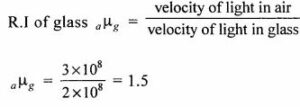
Question 30 A coin is placed at a depth of 15 cm in a beaker containing water. The refractive index of water is 4/3, calculate height through which the image of the coin is raised.
(a) 1.5 cm
(b) 6.75 cm
(c) 3.75 cm
(d) none of the above
Answer: (c) 3.75 cm
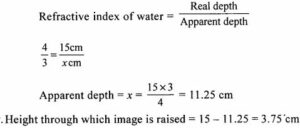
Question 31 The floor of a water tank appears at a depth of 2.5 m. If the refractive index of water is 1.33, find the actual depth of water.
(a) 3.325 m
(b) 6.650 m
(c) 9.975 m
(d) none of the above
Answer: (a) 3.325 m
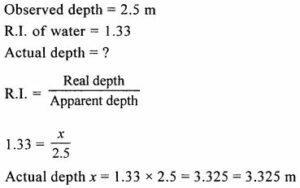
Question 32 A stone placed at the bottom of a water tank appears raised by 80 cm. If the refractive index of water is 4/3, find the actual depth of water in the tank :
(a) 640 cm
(b) 320 cm
(c) 160 cm
(d) none of the above
Answer: (b) 320 cm
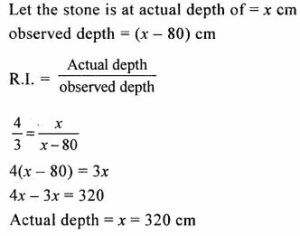
Question 33 or total internal reflection to take place a ray of light must :
(a) travel from denser to rarer medium
(b) travel from rarer to denser medium
(c) medium does not play any role
(d) none of these
Answer: (a) travel from denser to rarer medium
Question 34 The critical angle for a material X is 45°. The total internal reflection will take place, if the angle of incidence in the denser medium is :
(a) less than 45°
(b) 90°
(c) more than 45°, but not 90°
(d) less than 45°, but not zero degree
Answer: (c) more than 45°, but not 90°
Question 35 Small air bubbles rising up a fish tank appear silvery when viewed from some particular angle because of the phenomenon of :
(a) reflection
(b) refraction
(c) total internal reflection
(d) dispersion
Answer: (c) total internal reflection
Question 36 An isosceles totally reflecting prism can reflect rays through an angle of :
(a) 60°
(b) 90°
(c) 180°
(d) both (b) and (c)
Answer: (d) both (b) and (c)
Question 37 A ray of light is incident on the face of an equilateral prism at angle of 90°. The ray gets totally reflected on the second refracting face. The total deviation produced in the path of ray is :
(a) 60°
(b) 90°
(c) 120°
(d) 180°
Answer: (c) 120°
Question 38 A crack in the window pane appears silvery when viewed from some particular angle. This phenomenon due to :
(a) refelction light
(b) refraction of light
(c) total internal reflection of light
(d) dispersion of light
Answer: (c) total internal reflection of light
Question 39 When an equilateral prism is in minimum deviation position the angle of incidence is :
(a) greater than the angle of emergence
(b) smaller than the angle of emergence
(c) equal to the angle of emergence
(d) none of these
Answer: (c) equal to the angle of emergence
Question 40 When a ray of light passes through an equilateral glass prism :
(a) it suffers refraction on the first refracting surfaces
(b) it suffers refraction on both the refracting surfaces
(c) it bends towards the base on both refracting surfaces
(d) both (b) and (c)
Answer: (d) both (b) and (c)
Question 41 A ray of light after refraction through a lens emerges parallel to the principal axis of the lens. The incident ray either passes through :
(a) its optical centre
(b) its first focus
(c) its second focus
(d) its centre of curvature of the first surface
Answer 1 (b) its first focus
Question 42 A ray of light incident on a lens parallel to its principal axis, after refraction passes through or appears to come from:
(a) Its first focus
(b) Its optical entre
(c) Its second focus
(d) The centre of curvature of its second surface
Answer 2 (C) Its second focus
Study the following figure and tick the answer
Study the diagram given below.
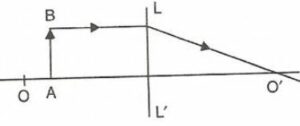
Question 43 Name the lens LL’.
(a) concave
(b) Convex
(c) Plane
(d) None of these
Answer (b) Convex
Question 44 – What are the points O and O’ called?
(a) first and second focal points
(b) second and first focal points
(c) centre of curvature and radius of curvature
(d) optical centre
Answer (a) first and second focal points
Question-45 State the three characteristics of the image.
(a) diminished, virtual and inverted
(b) magnified, real and upright
(c) diminished virtual and upright
(d) magnified, virtual and upright
Answer (d) magnified, virtual and uprights
Question 46 Name a device in which this action of lens is used.
a) camera
(b) eye glass
(c) magnifying glass
(d) All the above
Answer (d) All the above
Question 47 For an object placed at distance 20 cm in front of a convex lens, the image is at distance 20 cm behind the lens. The focal length of convex lens is:
(a) 20 cm
(b) 10 cm
(c) 15 cm
(d) 40 cm
Answer (b) 10 cm
Hint: As the object distance = image distance, the object must be kept at 2f.
Therefore, 2f = 20 cm or f = 10 cm.
Question 48 For the object placed between optical centre and focus of a convex lens, the image is
(a) Real and enlarged
(b) Real and diminished
(c) Virtual and enlarged
(d) Virtual and diminished.
Answer (c) Virtual and enlarged
Explanation: When the object is kept between optical centre and focus of a convex lens, the image is formed on the same side, behind the object. The image thus formed is virtual, enlarged and erect
Question 49 A concave lens forms the image of an object which is:
(a) Virtual, inverted and diminished
(b) Virtual, upright and diminished
(c) Virtual, inverted and enlarged
(d) Virtual, upright and enlarged
Answer (b) Virtual, upright and diminished
Hint: Concave lens forms virtual, upright and diminished image for all positions of the object.
–: End of MCQ Refraction of Light Through Plane / Prism ICSE Physics Class-10 :-
-: also visit :-
- MCQ Type Questions for ICSE Class-10
- ICSE Class-10 Text book Solutions, Notes , Syllabus, Paper, Notes
Please share with your ICSE friends if it is helpful
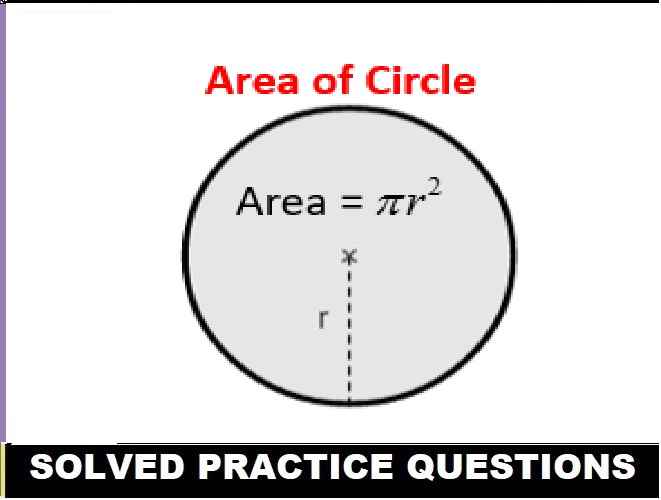

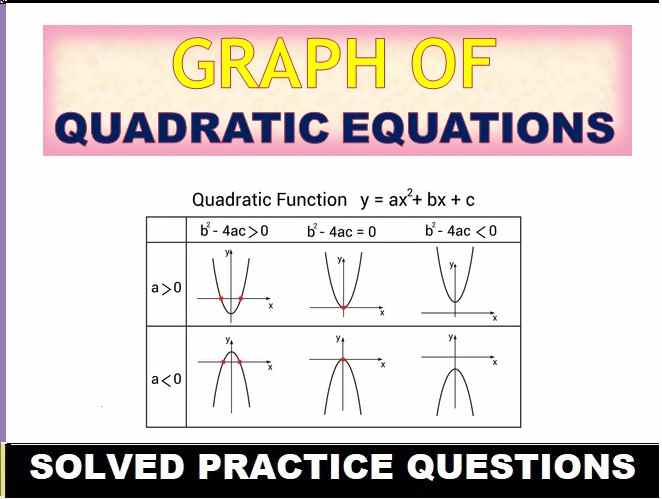
⭐⭐⭐⭐⭐
Standard MCQ’S
Very helpful
thanks a lot and focus on sem-2